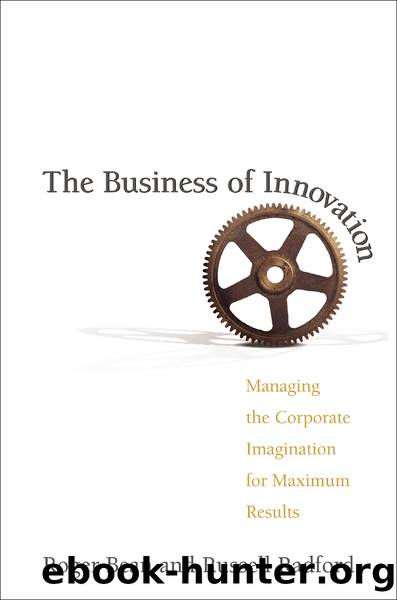The Business of Innovation by Bean Roger;Radford Russell;

Author:Bean, Roger;Radford, Russell;
Language: eng
Format: epub
Publisher: AMACOM
Published: 2002-08-15T00:00:00+00:00
NOTE
1. For an in-depth discussion of decision screens, see Roger Bean and Russell Radford, Powerful Products: Strategic Management of Successful New Product Development (New York: AMACOM, 2000).
CHAPTER NINE
LEVERAGING LOGIC
ARNAUD DE PONTAC WAS A member of the French merchant class, descended from artisans and on the rise socially. Titles would be forthcoming, but the lasting achievement of the Pontac family, and Arnaud in particular, had little to do with titles, French nobility, or French politics.
The Pontacs were lawyers and landowners. They had been upwardly mobile for over a hundred years prior to the period described hereâ1647. By any measure, they were not poor. But the stone-built family chateau, called Haut-Brion, was an hour from the city, situated on a mean patch of gravelly soil where little would grow. Arnaudâs country property would in fact grow little but vines, vines that had been producing wine here since the Roman occupation. Grapes grew rather well in Arnaudâs modest stretch of rocky terra.
Most of the wine produced here at the time was pretty ordinary and was sold to the Dutch, who were striking tougher and tougher bargains. With the exception of their favorite, sauterne, the Dutch merchants called for bulk wines, undistinguished by area or producer, and as we would say at the onset of the 21st century, price competition for undifferentiated commodity products becomes increasingly fierce. And so it was with wines of 17th-century Bordeaux.
Arnaud de Pontac was no man to stand aside and be driven to penury by the tightfisted Dutch. His property was capable of producing wine well above the average, and he vowed to change his fortune by changing his strategy. Rather than attempt to change the buying habits of the Dutch for the local wine, Pontac turned to London to improve his fortune.
Pontac selected the product of his very best vines to be sold by name, and he called this select produce Haut-Brion, after the family chateau. He produced another, lesser wine from the nearby area of Le Taillan that he sold simply as Pontac. The strategy was highly successful, and the English gentry quickly came to know that wonderful claret could reliably be found in the bottles named Haut-Brion. Samuel Pepys recorded in his diary having an unusually good wine, noting on April 10, 1663, âDrank, as sort of French wine, called Ho Bryan, that hath a good and most particular taste that I ever met with.â The first of the renowned French first-growth chateaus of Bordeaux had been born.1
Pontac had created the first brand name in the world of wine. His Haut-Brion and Pontac wine âbrandsâ were preferred and yielded premium prices over all other claret. Pontacâs innovation was not in technology, production (though he tended to quality), or viniculture. Arnaud de Pontac found his innovation in marketing. He broke out of the mold of bulk production of a commodity-grade product and created increased value by permitting his high quality to be identified by name. He was able to see his situation differently. He was able to think differently.
Download
This site does not store any files on its server. We only index and link to content provided by other sites. Please contact the content providers to delete copyright contents if any and email us, we'll remove relevant links or contents immediately.
The Brazilian Economy since the Great Financial Crisis of 20072008 by Philip Arestis Carolina Troncoso Baltar & Daniela Magalhães Prates(105725)
International Integration of the Brazilian Economy by Elias C. Grivoyannis(75527)
The Art of Coaching by Elena Aguilar(52202)
Flexible Working by Dale Gemma;(23213)
How to Stop Living Paycheck to Paycheck by Avery Breyer(19568)
The Acquirer's Multiple: How the Billionaire Contrarians of Deep Value Beat the Market by Tobias Carlisle(12113)
Thinking, Fast and Slow by Kahneman Daniel(11801)
The Radium Girls by Kate Moore(11627)
The Art of Thinking Clearly by Rolf Dobelli(9929)
Hit Refresh by Satya Nadella(8863)
The Compound Effect by Darren Hardy(8523)
Atomic Habits: Tiny Changes, Remarkable Results by James Clear(8054)
Tools of Titans by Timothy Ferriss(7824)
Turbulence by E. J. Noyes(7708)
Change Your Questions, Change Your Life by Marilee Adams(7384)
A Court of Wings and Ruin by Sarah J. Maas(7273)
Nudge - Improving Decisions about Health, Wealth, and Happiness by Thaler Sunstein(7255)
How to Be a Bawse: A Guide to Conquering Life by Lilly Singh(7162)
Win Bigly by Scott Adams(6831)
